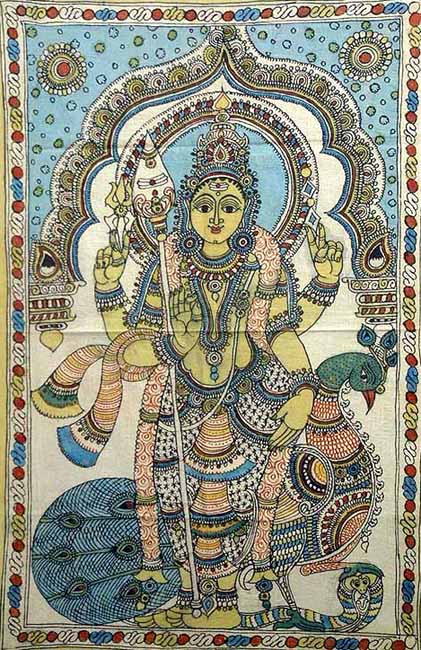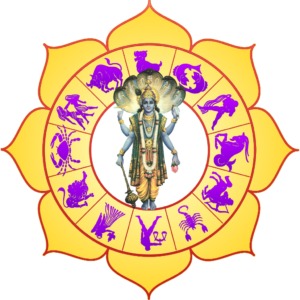Jyotiṣa Devatā
 As a subject, Jyotiṣa has a few major heads which include –
As a subject, Jyotiṣa has a few major heads which include –
• Lakṣaṇa Śāstra which means study of the omens and signs on the body and around. This includes Hastā-rekhā śāstra or palmistry which is the forte of Subrāhmaṇya or Kārtikeya
• Horā Śāstra is the forte of Gaṇeśa
• Gaṇita Śāstra including Vedic Numerology is another head
…. All these come under the three wings called Gaṇita, Horā and Saṁhitā
Once there was a debate between Kārtikeya and Gaṇeśa and Lord Śiva was the judge. Kārtikeya wrote the entire Lakṣaṇa śāstra whereas Gaṇeśa wrote Horā śāstra. Śiva judged horā to be superior to aṅga-lakṣaṇa (palmistry as well as all body study). In anger Kārtikeya threw the entire book into the ocean and from there it was retrieved partially by various teachers. Hence palmistry is also called samudrikā śāstra or that which has been retrieved from the samudra (ocean). That word samudrikā can also mean that which encompasses all the mudrā and mudrikā.
Praśna requires a study of aṅga lakṣaṇa and good ability in that as well as study of omens etc. which are a part of saṁhitā (nimitta śāstra). Hence anyone wishing to learn this has to worship Kārtikeya else he cannot learn this subject just as without Gaṇeśa, Horā śāstra will become very difficult. They are the original writers of these śāstra and they alone can teach what they have written.
In addition, Jyotiṣa is ruled by grīṣma ṛtu (among the six vedic seasons). Grīṣma ṛtu is ruled by Mars. Hence it is necessary to worship some form of Mars devatā for this study. Our tradition recommends the Narasimha sādhanā for this purpose. You are also taught Gaṇeśa sādhanā.
When we teach praśna course, then we will teach the worship of Kārtikeya as ‘Subrāhmaṇya’ and also the Praśna Upaniṣad … see the link. Kārtikeya is the teacher of this upaniṣad where Maharṣi Pippalāda is the śiṣya.
Jñānī Bhava ~ Namaskāra

 Lakshmi is a practising astrologer from Tirupati. As part of Jaimini India, she was one of the 3 teachers who taught Jaimini Upadesa Sutras at Bhimtal. She is a regular contributor to Jyotish Digest Magazine through her Vishnu Purana series.
Lakshmi is a practising astrologer from Tirupati. As part of Jaimini India, she was one of the 3 teachers who taught Jaimini Upadesa Sutras at Bhimtal. She is a regular contributor to Jyotish Digest Magazine through her Vishnu Purana series.  Pinnamaneni Bhanu Prasad became interested in Vedic Astrology when he met Smt. Lakshmi Ramesh during a visit to the holy temple city of Tirupati at the holy feet of Lord Venkateswara and Lord Shiva. This led to his study of Jyotish through the “Parāśara Jyotişa Course” with Pt. Sanjay Rath and qualification as “Jyotişa Paņḍita” from “Devaguru Brihaspati Center”. Bhanu also completed “Jaimini Scholar Program”...
Pinnamaneni Bhanu Prasad became interested in Vedic Astrology when he met Smt. Lakshmi Ramesh during a visit to the holy temple city of Tirupati at the holy feet of Lord Venkateswara and Lord Shiva. This led to his study of Jyotish through the “Parāśara Jyotişa Course” with Pt. Sanjay Rath and qualification as “Jyotişa Paņḍita” from “Devaguru Brihaspati Center”. Bhanu also completed “Jaimini Scholar Program”...
You must be logged in to post a comment.